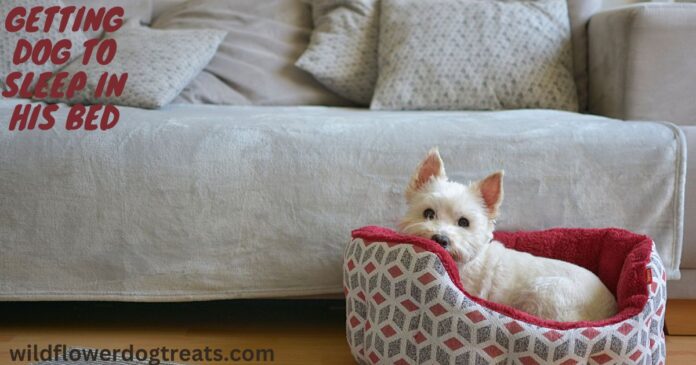To get your dog to sleep in his bed, establish a consistent bedtime routine and use positive reinforcement to encourage him to use his bed. You can also make the bed comfortable and inviting for your dog by adding his favorite toys or blankets.
As a responsible pet owner, it’s important to ensure that your dog gets enough quality sleep to stay healthy and happy. However, getting your dog to sleep in his bed can sometimes be a challenge. This article will provide you with effective strategies to help your furry friend feel comfortable and secure in his own sleeping space.
By implementing these tips, you can create a peaceful sleep environment for your dog and promote better rest for both you and your canine companion. Let’s explore some practical solutions to encourage your dog to sleep in his bed.
Understanding Your Dog’s Sleeping Behavior
Understanding your dog’s natural sleeping patterns and the factors that affect their sleep is crucial in helping them to sleep in their own bed. Recognizing these patterns and considerations will contribute to creating a sleep-friendly environment for your furry friend, ultimately leading to a healthier and more restful sleep.
Recognizing Natural Sleeping Patterns
Dogs, being den animals by nature, prefer to have a designated space to rest in. Their natural sleeping patterns are often governed by their evolutionary instincts. Dogs typically sleep for 12-14 hours a day, most of which is usually divided into short naps. Understanding and acknowledging this need for frequent, short rest periods is essential in accommodating your dog’s natural sleep rhythm. Creating a peaceful and comfortable space that aligns with these patterns will help in encouraging them to sleep in their own bed.
Factors Affecting Your Dog’s Sleep
There are various factors that can affect your dog’s sleep, including their age, breed, health, and their level of physical and mental stimulation during the day. Understanding and accommodating these factors can significantly influence your dog’s sleeping behavior. For instance, older dogs and certain breeds may require more comfort and support for their joints, while active breeds may need more mental and physical stimulation to help them unwind and rest. Additionally, any discomfort due to health issues or an unsuitable sleeping environment can also disrupt your dog’s sleep. Addressing these factors can help in establishing a routine that suits your dog’s individual needs and encourages them to sleep in their own bed.
Creating A Comfortable Sleeping Environment
To create a comfortable sleeping environment for your dog, ensure his bed is cozy and in a quiet space. Consider using a familiar blanket or toy to make the bed inviting. Establish a consistent bedtime routine to help your dog feel secure and relaxed, and avoid overfeeding or excessive exercise before bedtime.
Selecting An Appropriate Bed For Your Dog
Choosing the right bed for your dog is crucial in ensuring a comfortable sleeping environment. Consider your dog’s size, age, and sleeping habits when selecting a bed. Whether it’s a cushioned mat, nesting bed, or orthopedic foam bed, prioritize supportive and soft materials for your furry friend.
Placing The Bed In A Suitable Location
Positioning your dog’s bed in the right spot is essential for a restful sleep. Ensure the bed is placed in a quiet area, away from noisy appliances and heavy foot traffic. The chosen location should be comfortable and provide a sense of security for your dog.
Using Calming Scents And Sounds
Introducing aromatic scents like lavender or chamomile can help create a soothing atmosphere for your dog’s sleeping area. Additionally, playing soft, calming music or white noise can further promote relaxation and help your dog drift off to sleep more easily.
Establishing A Bedtime Routine
Helping your dog get comfortable with sleeping in their bed requires establishing a consistent bedtime routine. Dogs, much like humans, thrive on routine, and adhering to a set schedule can help regulate their sleep patterns and promote a sense of security.
Consistency In Sleep Schedule
A consistent sleep schedule not only helps in regulating your dog’s internal body clock, but it also sets expectations for when it’s time to wind down for the night. Ensure bedtime is consistently set at the same time each evening, keeping in mind your dog’s natural energy levels and individual sleep needs.
Incorporating Calming Activities Before Bedtime
Before bedtime, incorporate calming activities to help signal to your dog that it’s time to relax and prepare for sleep. This can include a walk, gentle massage, or interactive playtime.

Positive Reinforcement And Training Techniques
Teaching your dog to sleep in his bed can be achieved through positive reinforcement and effective training techniques. By offering rewards and utilizing training methods, you can encourage your dog to choose his bed as a comfortable and familiar sleeping spot.
Encouraging Your Dog To Use His Bed
When introducing your dog to his bed, it’s essential to make the experience positive. Place the bed in a quiet, comfortable area of your home, and use treats and affection to create a positive association with the bed. Encourage your dog to explore the bed on his own, and reward him with treats when he does so. Consistency is key, so ensure that you use the same positive reinforcement every time your dog chooses his bed for sleep or relaxation.
Addressing Any Sleep-related Behavioral Issues
If your dog exhibits sleep-related behavioral issues such as restlessness, pacing, or anxiety, it’s important to address these issues to create a positive sleep environment. Consider providing your dog with a special toy or blanket for his bed to provide comfort. Additionally, ensuring that your dog receives enough physical and mental exercise during the day can help alleviate any restlessness or anxiety at bedtime.
Integrating The Dog’s Bedtime Routine With Your Lifestyle
Integrating your dog’s bedtime routine with your lifestyle is essential for ensuring a harmonious coexistence. Dogs thrive on routine and structure, so aligning their bedtime habits with your daily schedule can lead to a more peaceful and restful night for both you and your furry friend.
Making Adjustments For Busy Or Unconventional Schedules
If you have a hectic schedule or work unconventional hours, it’s crucial to make specific adjustments to accommodate your dog’s bedtime routine. Here are some practical strategies to seamlessly integrate your dog’s sleep schedule with your busy lifestyle:
- Establish a consistent bedtime: Even if your schedule varies, try to maintain a regular bedtime for your dog. Consistency helps them feel secure and promotes better sleep.
- Allocate quality wind-down time: Prioritize spending quality time with your dog before bedtime, regardless of your schedule. Engage in calming activities such as a leisurely walk or gentle play to help them relax.
- Provide a designated sleep space: Regardless of when you get home, ensure your dog has a comfortable and familiar bed to rest in. This provides them with a sense of security and signals that it’s time to wind down.
Ensuring A Healthy Bedtime Routine For Your Dog
Irrespective of your schedule, maintaining a healthy bedtime routine for your dog is vital. Consider the following measures to ensure your dog’s bedtime aligns with your lifestyle:
- Consistent exercise: Ensure your dog receives ample exercise and mental stimulation during the day to facilitate better sleep at night.
- Limit late-night meals: Avoid feeding your dog a large meal right before bedtime. Instead, offer a light snack earlier in the evening to prevent nighttime disruptions.
- Establish calming rituals: Incorporate calming activities, such as gentle brushing or soothing massage, to help your dog relax before bedtime.
Frequently Asked Questions For How To Get My Dog To Sleep In His Bed
How Can I Train My Dog To Sleep In His Bed?
To train your dog to sleep in his bed, start by placing treats or toys in the bed to create positive associations. Use positive reinforcement, such as praise or treats, when your dog voluntarily goes to his bed. Consistency and patience are key to successful training.
Why Does My Dog Refuse To Sleep In His Bed?
There could be various reasons why your dog refuses to sleep in his bed, such as discomfort, insecurity, or a preference for sleeping in other areas. Evaluate the bed’s comfort, location, and your dog’s behavior to address any potential issues and make adjustments.
What Are The Best Types Of Dog Beds For Sleeping?
The best type of dog bed for sleeping depends on your dog’s size, age, and sleeping preferences. Consider options such as orthopedic beds for older dogs, raised beds for warmer climates, or cozy, enclosed beds for dogs who seek a sense of security during sleep.
Conclusion
Incorporating these techniques can enhance your dog’s sleep habits and ensure they sleep in their bed. Consistency and patience are key to success. By addressing any underlying issues and creating a comfortable sleep environment, you can encourage your dog to embrace their own bed for a restful night’s sleep.



